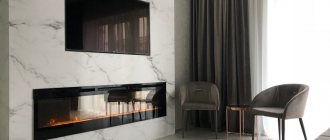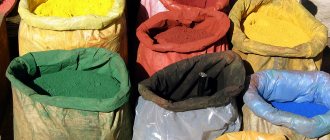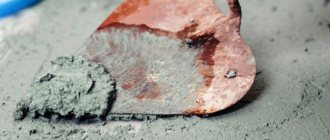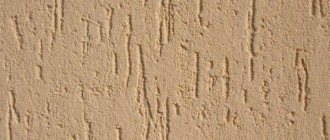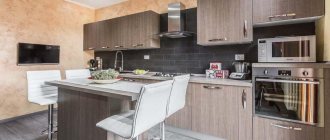You can create a luxurious interior with ceilings and walls imitating natural marble using Venetian plaster, which imitates expensive natural material. Venetian marbled plaster, which is more affordable, is successfully used both for interior decoration and for building facades.
Modern materials for applying Venetian plaster are manufactured using new technologies. Mostly synthetic materials (acrylic or polymer compounds) are used as binders. For interior decoration, small stone chips are added as a filler, and for facades, slightly larger ones. Then a finishing coat of natural (very expensive) or cheaper synthetic wax is applied.
Low-cost options are widely used - putty mixtures without stone chips with a finishing coat of acrylic varnish.
Features of Venetian plaster
There are different types of Venetian plaster and different techniques for applying it. It is used both for the entire area of walls or ceilings, and for their individual sections, as well as for the decoration of arches, columns and other interior elements. Such finishing materials are vapor-permeable and therefore allow surfaces to “breathe”. They are safe for health and therefore suitable for all types of premises.
The coatings are very durable and moisture resistant and do not accumulate condensation. Suitable even for bathrooms and other rooms with high humidity.
Imitation of Venetian decorative plaster can be:
- under natural stone (marble, granite, etc.) with a matte or polished surface;
- nacre;
- silver or gold;
- craquelure (with cracks);
- with a velvety surface.
Venetian plaster imitating natural marble
But the most common is Venetian plaster imitating marble, which has several varieties:
- Carrara - applied in several translucent layers of different tones, ultimately creating the effect of varied tints;
- Trevignano - a multi-color range is used, creating the effect of radiance from within;
- Veneto - resembles polished marble, gives the room an exquisite aristocratic look, popular because of its rich appearance at low cost;
- marbello - resembles cut stone with a velvety surface and glossy veins, “plays” with shades when the lighting changes;
- imperiale - with the addition of golden pigments, a beautiful shining marble surface is obtained.
Imperiale
Veneto
Criteria for choosing a plaster mixture
It is recommended to prepare the mixture yourself if you want to practice the process. The stores have a wide selection of ready-made materials that only need to be given color. Professional tips for choosing a mixture:
- It is necessary to decide what surface the coating will imitate - marble, onyx, quartz, etc.
- Then decide whether the coating will be matte or glossy.
- Next, choose a mixture based on lime or acrylic. The first one is more difficult to apply, but has an interesting texture. The second one is stronger and dries faster.
Date of manufacture
It is recommended to check the expiration date indicated on the packaging. It lasts no more than 12 months in a dry, unopened form; an expired mixture cannot be used.
Marking
In addition to the date, the packaging indicates the conditions of use, composition, and drying time. This information will help in organizing work.
Tools for working with Venetian plaster
To perform this type of finishing work, you can save money and completely do without hiring a specialist, because these services are expensive.
This requires a painter with artistic skills. If you have creative abilities, you can handle this work yourself.
To make high-quality marble Venetian plaster with your own hands, you will need to follow all technological processes, prepare the necessary tools that are convenient for work, and also select suitable finishing materials from well-known manufacturers.
Choose a trowel with round edges to avoid scratching the wall.
You will need the following tools for work:
- trowel - for uniform distribution and leveling on the surface of a regular plaster mixture (or with fine filler), as well as for drawing veins
- rubber spatula - for applying the final wax coating;
- metal brush or grater - if you need to apply plaster with coarse filler;
- narrow spatula - for applying finishing material from the container to the trowel;
- roller and wide spatula - for applying primer;
- several containers of suitable size for stirring and storing plaster of various shades;
- sandpaper for leveling the surfaces being treated, because they must be perfectly flat;
- a drill with a mixer attachment - to stir plaster with added colors in containers;
- grinder with a polishing attachment - to get a mirror-smooth marble surface;
- dry, clean rags - for sanding the finished surface in hard-to-reach places;
- rags - for wiping tools.
To clean, use fine sandpaper so that the drawing does not leave deep scratches, for example No. 320
Depending on the decorative type of coating, the technique for applying plaster may differ, so the list shows only the basic materials that will be required for the work:
- primer filled with fine-grained quartz;
- plaster mixture;
- several colors to create mixtures of different shades;
- water;
- wax - paste or liquid.
Venetian made from putty - is it possible?
Ready-made mixtures are expensive. To reduce the cost of work, craftsmen came up with a Venetian coating made from ordinary putty. The main thing for an analogue is the presence of a smooth texture and the desired consistency. How to make Venetian plaster with your own hands? The recipe is simple - mix regular gypsum putty with acrylic varnish. To make Venezian stucco from putty with your own hands, take:
- acrylic varnish for interior work with a water base,
- gypsum or polymer dry mixture with microcalcite or marble flour as a filler (putty with white cement can be used),
- color.
Varnish is poured into a clean vessel and water is added - 10-15% of its volume. After stirring, add 2.5 kg of dry putty. Everything is mixed with a mixer, tinted, mixed again. Venetian putty plaster is painted with colors for water-dispersed paints. Ultimately, Venetian putty, with its qualities, can be no worse than store-bought putty and can be used not only in the apartment, but also for outdoor work. You can slow down the hardening time by adding a plasticizer - diluted PVA glue in an amount of 1% of the volume of the mixture.
And yet, the purchased mixture will look much better, because... It will not be possible to completely replicate the plant technology at home.
You can do without putty. For example, a simple composition of Venetian in the following proportions: 1 part white cement, 1.5 parts lime, 2 parts marble flour, 10 parts marble sand.
Stucco Veneziano, which began as an imitation of natural marble, became an object of imitation itself. They produce wallpaper on various bases that imitate your favorite finish. Wallpaper that can be painted with Venetian wallpaper is cheaper and has its pros and cons. The work of wallpapering and the technique of such decoration is simpler and easier. However, they cannot fully replace the Venetian, and therefore it will appear again and again among the leaders of interior tops.
Venetian plaster is developing and enriching, the application technology of which, with the advent of new finishing compositions, is acquiring more and more new ways of development. Finishing compositions and new techniques are being invented. A new finishing material has appeared on the market - super glossy decorative Pietra Lucida. The manufacturers themselves refer to this killer of the classic Italian technique of imitation marble not as a Venetian, but as a polishing compound. The work is more drawing, the technique of imitation is also simple. Using colors of natural tones, a mirror-smooth texture is obtained, similar to polished natural stone.
How to properly prepare the surface
To apply a layer of Venetian, a perfectly flat surface is required.
Therefore, it is necessary to carefully prepare it first - level it using ordinary plaster and putty, sand it, and prime it.
Despite the high strength of the finished layer of Venetian plaster, if the base is of poor quality, cracks may appear after a few years.
To avoid this, it is necessary to ensure the stability of the surface in advance and, if necessary, use reinforcing materials.
Before applying decorative plaster, make sure the wall is perfectly flat
The best base is considered to be finishing the walls with plasterboard. They have perfectly flat surfaces, are fixed to frames and are relatively resistant to deformations that may occur in load-bearing structures. Walls of panel houses and monolithic partitions are suitable.
But stone and brickwork are most susceptible to deformation during the operation of the building, so they must be strengthened with reinforcing materials.
It is important to apply a layer of Venetian putty very thin, about 1 mm. Therefore, all the smallest irregularities must be corrected in advance. For this, after reinforcing and plastering the walls, gypsum putty is additionally used.
When preparing the base, you must also take into account its ability to absorb moisture. This applies to cement and lime plaster. In these cases, it is necessary to use primers that penetrate deeply into the plaster layer.
Scope of application
The finished Venetian coating is particularly durable. This type of plaster is used to finish surfaces in residential and non-residential premises. It looks impressive both on walls and ceilings. In some cases, Venetian plaster is used to finish floors.
Sometimes Venetian is used for exterior work, finishing the walls of buildings. This is possible due to the material’s resistance to temperature changes and precipitation.
Pros and cons of Venetian plaster:
- High decorative qualities
- Strength
- Durability
- Color fastness
- Light reflection
- The mixture lays evenly, does not create seams or joints
- High price
- Requires careful preparation of the base
- Experience is required for quality application.
Techniques for applying Venetian plaster
Before performing decorative work, it is necessary to prepare in advance all the shades of plaster mixtures included in the color scheme of the drawing. Basically, only the white color of Venetian plaster is on sale, and the desired color can be obtained by adding a suitable color to it.
It is recommended to prepare all color mixtures at once in the required quantity, because then it will be difficult to choose the same shade.
You should also take into account that water-based paints change their shades when drying. Therefore, you need to check what color you will get in the end - to do this, apply the finished mixture to the rough surface and wait for it to dry. If it does not match the desired shade, then add more color or white mixture.
First, the entire working surface is covered with the main (base) layer, and after it has completely dried, the next layers, depending on the design, are applied using artistic techniques. Using various painting techniques, you can obtain a wide variety of beautiful surfaces with an imitation of natural marble.
Base layer
For the main layer, choose the shade that predominates in the color scheme. If you want to achieve the effect of white marble, then choose white tones as a base. This mixture must be prepared in sufficient quantity, in the largest container.
A base layer of decorative plaster is applied immediately over the entire surface, in a thin layer, using cross movements of the trowel in different directions. The tilt of the trowel should be at an angle of 40°-70°.
At this stage, a smooth glossy surface is created, on which it will be convenient to apply a design in the future, and the main color of the decorative coating is also obtained. You can begin the next stages of applying layers of the selected pattern when the base is completely dry. Mixtures based on acrylic and polymer bases dry quite quickly, some within 2 hours. The drying time differs for different types of putty; it is indicated on each package.
Classic multi-layer marble effect method
Next, three or more coatings are applied to the base layer. For each of them (in the classic version), one color is selected and applied in a very thin layer. You need to wait until it dries completely and then apply a second one. Depending on the brand of the composition, this can last from 1 to 10 hours.
All strokes should be made chaotic in different directions. The result is shapes and lines reminiscent of marble patterns.
Layer is formed
chaotic strokes
How to apply layers correctly
The depth and brightness of the coating largely depends on the number of layers.
Each subsequent layer should be thinner than the previous one, and the last one should be the most transparent.
If the first of them can be applied with large chaotic strokes, then with all subsequent ones it is necessary to form the desired pattern, working out the details.
One color is used in the work
Working with multiple colors
Beautiful drawings are obtained by using several colors at the same time. The first layer is made one color, and then several mixtures of different shades are applied to the trowel at the same time with a spatula and mixed. Applying the first multi-color layer creates larger details in the design, and then builds up the details with each layer, giving you a faux marble finish on your walls.
The work was done in several colors with drawing
The video shows how to correctly apply several tinted materials on a spatula at once and how to create a marble pattern:
Venetian “marbled” drawing
The applied lines, cracks, inclusions and other patterns look very impressive, more accurately emphasizing the features of the marble surface. To draw such details, spatulas or thin brushes are used.
Veins are painted with thin and thick brushes
Stages of drawing
Drawing the Venetian is done at the final stage, when all the colored layers are applied and the surface is smoothed with sandpaper. To apply the pattern, a color diluted with water is used. Depending on the design, brushes are selected. For example, to apply inclusions you will need larger sizes, and to draw veins, thin brushes.
Watch the video on how to create Venetian plaster to imitate white marble with veining of different thicknesses:
Working with the finishing layer
The finished surface must be prepared for applying a protective layer. It is carefully sanded to obtain a perfectly even layer. In some cases, the ironing method is used - grinding the surface with a spatula made of durable stainless steel, which results in the effect of a smooth mirror surface.
After sanding, the places where the first layers were applied are revealed, which makes the drawing more interesting.
Create a polished marble effect
Venetian plaster allows for a variety of techniques. One of the interesting ones is polished marble. Its difference is its ability to refract and reflect the sun's rays. Such interiors turn out lighter, more voluminous, and filled with air. Polished marble is widely used in the classic design of country houses:
- For plastering, use a spatula with rounded edges.
- The working mass is applied with vertical movements, with different pressure and direction.
- The classical technique involves 3 or more approaches to create the desired pattern.
- The walls are dried for a week. After this, beeswax is applied. It is responsible for the glossy effect.
- Polish with a suede mitten. It is put on the hand. The movements are made in a circular, smooth manner, with light pressure.
It is recommended to apply Venetian plaster using a spatula with rounded edges.
Venetian plaster treated with beeswax has a special gloss.
Photos of modern versions of Venetian plaster in the interior
Using Venetian plaster you can create an amazing variety of beautiful interiors. See samples in the photo. For any interior, you can choose the right color scheme and marble pattern. In an accessible and relatively inexpensive way, you can decorate your room, giving it a rich, respectable look.
Tyutyunnikov Dmitry
Article verified by a decorative finishing specialist
Useful tips
To achieve the best effect when working with the Venetian on your own, you need to take into account the main points:
- make sure that the selected mixture will give an effect that is ideal for the room;
- study the application method in theory, and then practice on a small area, remembering the proportions and adjusting the result based on the resulting coating;
- keep the instrument and container clean, as mixing shades can spoil the effect;
- The finished plaster must be stirred periodically, as it produces sediment.
Whatever application technique the artist follows, it is worth periodically changing the direction of the shape or pattern.
Sources
- https://www.InMyRoom.ru/posts/16571-venecianskaya-shtukaturka-v-interere-kvartiry-foto-harakteristiki-sovety-po-ispolzovaniyu
- https://proffstroygroup.ru/dekor/venecianka-na-stenah.html
- https://StrojDvor.ru/remont/venetsianskaya-shtukaturka/
- https://PoShtukaturke.ru/steny-vnutri/decor-vnutri/nanesenie-venecianskoj-shtukaturki-pod-mramor.html
- https://kraska.guru/smesi/shtukaturka/venecianskaja.html
- https://building-ooo.ru/suxie-stroitelnye-smesi/venecianskaya-shtukaturka-vidypreimushhestvananesenieraznovidnostifotoopisanie/.html
- https://couo.ru/kvartira-i-zagorodnyj-dom/dizajn/venecianskaya-shtukaturka-dobavte-intereru-shika.html
- https://design-homes.ru/idei-dlya-doma/venetsianskaya-shtukaturka-foto
- https://oshtukaturke.ru/raznovidnosti/venetsianskaya-shtukaturka
- https://1oschtukaturke.ru/metody-naneseniya/venetsianka-pod-mramor
- https://stroyhelper.ru/venetsianskaya-shtukaturka/
- https://DekorShtukaturka.ru/dekorativnaya-shtukaturka/venetsianskaya-shtukaturka
- https://m-strana.ru/design/venetsianskaya-shtukaturka-vidy-sposoby-otdelki-i-ukhod/
- https://materialyinfo.ru/venecianskaya-shtukaturka/
Recipe - 1 (materials)
Marble is one of the most expensive materials, and therefore replacing it with decorative putty saves money. There are several methods for creating a coating that allows you to create an imitation of marble from putty. Each of them has its own characteristics.
An imitation of the structure of marble can be obtained if you use:
- About 2 packets of putty powder.
- 30 g of any liquid soap.
- 1 package of marble chips.
- 200 ml water.
- Pigments of the required tones.
After kneading, the mixture should not be too thick.
Adviсe
In order for marble plaster to adhere well and the finish to be durable and beautiful, you should follow several rules during the work.
- All work must be carried out in dry, but not hot weather. It is undesirable for the sun's rays to fall on a freshly treated surface.
- Lamps, if there are any on the walls, should not be turned on until the plaster is completely dry.
- The thickness of the plaster layer should not be more than twice the size of one filler crumb.
- Plaster should be applied to one wall continuously to avoid the appearance of unevenness.
- If it is cool outside, then the plaster should be given at least two days to dry completely.
- The drawing is best applied using patterns.
- If coarse marble plaster is used, it can also be applied to rough plaster. But the fine-grained one should be applied to clean putty or a sanded smooth surface.
Marble plaster is a universal method that allows you to hide imperfections in the walls of a building and give them a presentable look.
Prices for different types of plaster floats
Plaster grater
Finish coating
It is best to further protect the plaster layer after complete drying. For example, you can varnish, but only after the layer has dried for 24 hours.
You will need to first sand the surface and apply paint in order to highlight the beauty of the texture.
Then apply varnish, preferably water-based, and let it dry completely. This varnish dries quickly and spreads better over the surface of the plastered wall. The paints used are the same as for interior and facade work, taking into account the specifics of use.
Wax will also help refresh faded paints and highlight the texture. It will also protect against dust, dirt and mechanical damage.
Where is it used?
Since marble plaster is an environmentally friendly material, it can be used on any surface - at the final stage of finishing, both to cover the walls of the interior of the house and to decorate the facade. At the same time, it looks discreet, but impressive, stylish, and presentable. It is used to finish concrete and brick, stone and wood, plasterboard and chipboard. It even sticks to water-based paint!
On a note! Using marble plaster, you can decorate columns, balconies, and all kinds of arches very beautifully.
Steps finished with marble plaster
However, such plaster is rarely used in the interior of a living space - the material is too “cold”. But flights of stairs, halls, and corridors decorated with its help will look harmonious. And on the facade, such plaster always looks advantageous.
Decorative plaster TERRACO (mosaic, marble chips)
Stone chips in the exterior
Preliminary stage
Without preliminary preparation of the surface, it is impossible to finish the walls efficiently; this stage of work must be carried out especially carefully. The main condition for simulating the selected texture is that the plane upon completion of preparation must be smooth and clean. First of all, get rid of the old putty. After this, the walls must be degreased. All existing defects in the form of cracks and irregularities are eliminated. The cracks are most often sealed with plaster.
To imitate a marble texture, a sand-cement mixture, unlike gypsum, requires more time to dry. In this case, work can be continued only after a few days. It is advisable that the room temperature at this time be at +20ºC.
Advantages and disadvantages
Like any other finishing material, marble plaster has its advantages and disadvantages. It is worth familiarizing yourself with them to decide whether you need to contact this material at all, or whether it is better to use other finishing methods.
Plaster with marble chips - options
The advantages of marble plaster are given below.
- High strength and resistance to mechanical stress, which ensures the durability of the final coating. Although in fairness it is worth noting that plaster based on granite chips is much stronger.
- Large selection of colors and the ability to combine different shades during work.
- Vapor permeability is also high, due to which condensation does not accumulate on the main wall of the house, surfaces can “breathe”.
- Marble plaster is an environmentally friendly material; it does not harm health or the environment.
- This coating is not afraid of ultraviolet radiation, rain, wind, snow. It does not lose its color over time.
- The material can be worked in almost any conditions, and the application technology is quite simple.
- Marble plaster coating is very easy to maintain and easy to clean.
- Mold and fungi do not live on the coating.
Marble plaster of house facade
However, there are also some disadvantages.
- Marble plaster is susceptible to exposure to certain chemicals. In particular, these are acids such as hydrochloric acid.
- The cost of the material is quite high.
Of course, marble plaster has many more advantages than disadvantages. It is not too fancy in its work, and therefore it can really be used for finishing the facade.
Decorative plaster made of colored marble chips
